In This Issue :
Clinical Trials Can Provide Many Benefits to Participants
Clinical trials in vision research have led to new medicines and surgeries that have saved or improved sight for thousands of people. Patient participation is the critical ingredient for a successful clinical research study.
Participating in a clinical trial can bring patients many benefits. Patients can be among the first to benefit from a new treatment being studied. Those patients not receiving the new treatment during the clinical trial may be among the first to benefit from the new treatment when the study is over.
Quality Care
Clinical trial patients receive the highest quality medical care. Experts watch them closely during the study and may continue to follow them after the study is over.
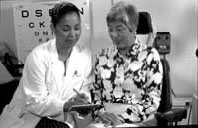
Patient participation is a critical
component for a successful clinical
research study.
People who take part in these trials contribute to new knowledge that may help other individuals with the same eye problems. In cases in which certain eye diseases or disorders run in families, participation may lead to better care for family members.
Despite these benefits, minority population groups are underrepresented in clinical trials. Some recent studies have reported that African Americans have increasingly positive attitudes toward medical research. Yet, several studies show that African Americans are still cynical about clinical trials, suggesting a lack of trust in the medical establishment.
Cultural Barriers
Other barriers include culture and language. Many Hispanics/Latinos, for example, feel more comfortable with Hispanic/Latino health care providers and researchers. They prefer professionals who have an understanding of or appreciation for their culture.
For progress to be made in medicine, representation from all groups is needed. Minorities, who are disproportionately affected by many diseases, should especially be encouraged to participate in clinical trials so treatments can be developed for them. New treatments studied on a variety of populations provide evidence of effectiveness in different groups.
Many patients learn about clinical trials from their doctors. Physician advocacy is crucial to ensuring patient participation. Health care professionals can find the latest information about NEI clinical trials at www.nei.nih.gov/neitrials. The NEI supports clinical trials at about 250 medical centers, hospitals, universities, and doctors' offices across the country.
The booklet, Clinical Trials in Vision Research, helps patients and their families understand what is involved in participating in an NEI clinical trial. It answers common questions about what clinical trials are and where and how they are conducted. Clinical Trials in Vision Research can be ordered by calling toll-free 1-800-869-2020.
Glaucoma Clinical Trials
Lead to Improved Treatment and Quality of Life
A Step Forward for Prevention and Eye Health Education
Clinical trials funded by the National Eye Institute have led to improved treatments for primary open-angle glaucoma, the most common form of glaucoma and a leading cause of irreversible vision loss in the United States. Glaucoma affects 2.2 million Americans.
The Glaucoma Laser Trial represents a significant advancement in the treatment of glaucoma. The trial showed that laser therapy is a safe and effective alternative to eyedrops as a first-line treatment for patients with newly diagnosed glaucoma. The results demonstrate the importance of detecting the disease early by having a dilated eye exam at least once every two years.
The Advanced Glaucoma Intervention Study found that Blacks and Whites with advanced glaucoma respond differently to two surgical treatments: Blacks benefit more from a regimen that begins with laser surgery; whereas, White patients benefit more from treatment that starts with an operation called a trabeculectomy. This study produced the first evidence that members of two racial groups benefit from different treatments for glaucoma and provided doctors with better information for recommending treatment programs. Thus, people with advanced glaucoma have a better chance to preserve and prolong their vision.
In the Early Manifest Glaucoma Trial, scientists learned that immediate treatment of newly discovered primary open-angle glaucoma led to a slower rate of disease progression. The findings from this study reinforced medical evidence that lowering eye pressure in glaucoma's early stages slows progression of the disease. The study also found that glaucoma treatment should be tailored to the individual needs of the patient.
Recently, researchers in the Ocular Hypertension Treatment Study discovered that eyedrops used to treat elevated pressure in people at higher risk for developing glaucoma may delay, and possibly prevent, the disease. Several significant risk factors were found to be associated with the development of glaucoma, including older age and African descent. Ocular risk factors, such as higher eye pressure, certain characteristics in the anatomy of the optic nerve, and thinness of the cornea also were identified as significant.
For more information on these clinical trials, visit www.nei.nih.gov/neitrials.
Healthy Vision Community Projects See Results
Screenings at African American churches. Training teachers, parents, and caregivers to identify visual problems in children. Conducting eye disease risk assessments on inner-city residents. Forming a statewide partnership to focus on aging eye disease. Delivering eye safety messages to Spanish-speaking farmworkers. Increasing underserved older adults' awareness of vision rehabilitation.
The 34 community-based projects funded in 2003 are incredibly diverse, yet focused. Many projects have completed their groundbreaking work. Others are finishing up and preparing final reports. Seven have been chosen to continue their work. (See "43 Organizations Receive Healthy Vision Awards".)
The National Eye Institute (NEI) has set several objectives for projects funded under the Healthy Vision Community Awards Program:
- To support the achievement of the Healthy Vision 2010 objectives and the Healthy People 2010 goal to reduce health disparities.
- To strengthen the capacity of community-based organizations.
- To identify innovative projects with potential for sustainability and replication.
Awardees are encouraged to focus on their work in the community, not on paperwork. According to the latest project reports, the program is working.
For the Montgomery County (Maryland) Department of Health and Human Services, the main lesson learned is: "...teaching others how to screen for vision problems and lending vision charts and Timus machines greatly increases the number of children screened." Altogether, the county trained 35 people at 20 nonpublic schools, including two schools with special needs populations.
Similar results have been reported by Prevent Blindness North Carolina. The agency recruited, trained, and assigned 1,000 new volunteer high school health occupation students as vision screeners for students in kindergarten through sixth grade in 50 poverty counties across the state. A total of 174,017 children were screened; 10,540 were referred for possible vision problems.
The North Carolina project has had unexpected dividends: A child diagnosed with amblyopia was not covered for the therapeutic patch so someone at the school donated enough money. Calls to the U.S. Department of Health and Human Services have resulted in a change in Medicaid coverage for children with vision problems in North Carolina.
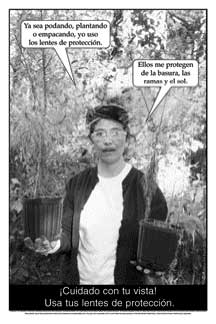
To prevent eye injuries among farm
workers, the Rural Women's Health
Project created posters like the one
above.
The New England Eye Institute demonstrated the effectiveness of direct outreach at community and cultural/ethnic events throughout greater Boston and the importance of followup practices. The project conducted 10 events and also performed 541 verbal risk assessments at four health centers. Two out of five people failed, and many of those also failed to keep their followup appointments. One of the reasons turned out to be a knowledge barrier: Immigrant populations do not have a full appreciation of routine eye care.
The "Ohio's Vision...Awaken to the Challenge" conference hosted by Prevent Blindness Ohio brought together 110 researchers, eye care professionals, social services agencies, and others interested in aging eye disease. The new Aging Eye Public/Private Partnership within the Ohio Department of Aging is being formed. Its mission will include advising state agencies and organizations to ensure a consistent and comprehensive statewide plan of action for aging eye disease.
In its report about lessons learned, the Rural Women's Health Project stresses the importance of tailoring the message, because "eye safety glasses need to vary from crop to crop." Message tailoring also is necessary for racial and ethnic groups and for different aspects of farm work.
The project now is distributing printed copies of posters and handouts and has posted free, downloadable posters on its site (www.rwhp.org) and the Farmworker Eye Network (www.fenet.org).
Personal stories illustrate the results of the Visually Impaired Elders Project sponsored by MAB Community Services in Boston, MA. Her recreational activities were once limited, but now an 86-year-old woman is reading music again and singing with her friends. She is taking advantage of improved task lighting, a magnifier, bold-print pen, and other vision rehabilitation devices. "For the first time in a long time, I am able to cook myself a big breakfast," reported a 73-year-old African American man with glaucoma. He now has tactile-raised markers on the stove dials, plus other devices to help him maintain independence.
Similar markers enable an 80-year-old woman with macular degeneration and cataracts to bake with confidence. She now knows about the Talking Book Library and can enjoy her favorite mysteries in the comfort of her own home. Another moving story is that of an 85-year-old woman living on a farm in rural Massachusetts. She didn't want to be "imprisoned in a nursing home" and unable to feed the chickens she has kept for decades. She can find the feed pail thanks to a bright circle of tape placed around it. She says she "isn't bad enough off, yet" to join a support group. The project is encouraging her to attend, because "she would be an example to other visually impaired older adults that losing your sight doesn't mean you must lose your independence."
The Whittier Street Health Center reported a happy ending to an unfortunate beginning when a scheduled community center screening conflicted with "bingo" time. To make up for the poor turnout, the center's director brought everyone needing an eye exam to the health center. The show rate was 100 percent!
Results and lessons learned from the Healthy Vision 2010 Community Awards Program will be published on the Website www.healthyvision2010.org.
EyeCare America Supports Campaign
EyeCare America (ECA), the public service foundation of the American Academy of Ophthalmology, partnered for the first time with the Office of Minority Health, U.S. Department of Health and Human Services (HHS). In this partnership, ECA supported the national health care improvement campaign, "Take Your Loved One to the Doctor Day" on September 16, 2003.
ECA created a Web page with a downloadable poster, news release, and a letter-to-the-editor template. The materials encouraged older adults, friends, and family members who are without an ophthalmologist to call the Seniors EyeCare Program helpline at 800-222-EYES. Callers to the helpline can find out if they are eligible to receive a referral to a volunteer ophthalmologist.
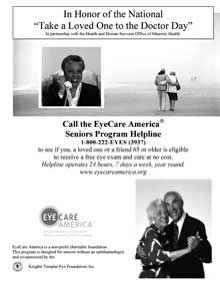
EyeCare America supported
"Take a Loved One to the Doctor Day.
The Web page also invited organizations to partner with ECA on this campaign. The response was tremendous. Every state ophthalmological society joined ECA in support of Take Your Loved One to the Doctor Day campaign. Additional partners to the HHS campaign included the Knights Templar Eye Foundation, Inc.; Administration on Aging; Prevent Blindness America; subspecialty societies; and health departments across the country.
The ECA effort generated more than 130 news articles and letters to editors. The Seniors EyeCare Program helpline, co-sponsored by the Knights Templar Eye Foundation, Inc., received more than 2,600 calls in September.
Founded in 1980 to preserve sight, EyeCare America accomplishes its mission through public service and education. In the United States, EyeCare America is one of the largest providers of eye care services to medically underserved people and educates the public about the eye and vision. In developing nations, EyeCare America helps improve eye care by providing free educational resources and materials to ophthalmologists.
The largest program of its kind in the United States, EyeCare America provides access to eye care for medically underserved people and those at increased risk for eye disease. Its corps of 7,500 volunteer ophthalmologists is dedicated to serving communities nationwide. More than 90 percent of the care made available through EyeCare America is provided at no out-of-pocket cost to the patients. Public service includes programs for older adults and children and on glaucoma and diabetes. Since its inception, EyeCare America's public service program has handled more than 644,000 calls, provided services to 347,000 people, and treated more than 180,000 cases of eye disease.

Health care improvement campaigns provide organizations the opportunity to partner with existing public service programs and make a difference in their local communities. EyeCare America looks forward to working on this and other campaigns in the future. For more EyeCare America information, visit www.eyecareamerica.org or call 415-561-8520.
Order this free program and give hope to people who have low vision.
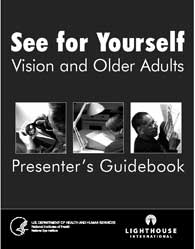
One in 20 people has low vision and find everyday tasks difficult to do. Yet, many of them are not aware of services and devices that can help them make the most of their vision.
The See for Yourself: Vision and Older Adults program is designed to educate adults about changes that affect their eyes as they get older and to motivate them to take an active role in decisions concerning their vision.
The program includes:
- An educational video
- Presenter's guidebook
- Booklets on low vision
To order, call: 1-800-869-2020 or visit www.nei.nih.gov.
General Eye Health Brochure Now Available in Spanish
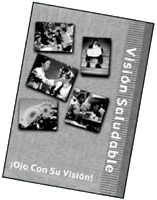
The National Eye Health Education Program has published a Spanish-language brochure on general eye health. The new booklet, Visión Saludable, is a comprehensive, easy-to-read publication that provides Spanish-speaking adults and their families and friends with information about eye health as well as educational information about eye diseases. It features sections on diseases that can affect our vision, including diabetic eye disease, glaucoma, and cataracts. It also has sections on common vision problems, how to talk to your doctor, and myths and facts about eye care. The booklet provides information on the resources available to help prevent vision loss as well as resources for those who cannot see as well as they once did.
To order, call: 1-800-869-2020 or visit www.nei.nih.gov.
Student Sight Savers Program
Medical Students Gain Experience With Eye Disease
From their first day in medical school, students are bombarded with a significant amount of new information. The human visual system must compete for their attention with physiology, biochemistry, physical diagnosis, and other topics. Thus, students may graduate with just very basic knowledge of ophthalmology.
Thanks to grants from the Friends of the (United States) Congressional Glaucoma Caucus Foundation, Inc. (FCGCF), medical students across the country are learning about eye disease before they become submerged with additional responsibilities in their clinical years. The Student Sight Savers Program (SSSP) was started at the University of Michigan as a community outreach service years ago.

A medical student examines a
patient during a glaucoma screening.
Dr. Ehsan Sadri, an ophthalmology resident at the University of Maryland and a former student at the University of Michigan, adapted the program for the University of Maryland School of Medicine (UMSOM) with seed money from FCGCF. First- and second-year students are trained to screen for glaucoma. They use equipment provided by the FCGCF grant: the Titmus, frequency doubling perimeter, and direct ophthalmoscopy. The experience enhances each student's knowledge about eye disease.
The SSSP at the UMSOM is in its second year as an active student-run organization. In addition to planning eight to 10 community screenings, the students hope to establish a followup clinic for patients they screen. This clinic would allow patients at high risk for glaucoma and without health insurance to undergo comprehensive eye examinations and treatment.
FCGCF has provided funds to other schools to establish similar programs, including Harvard University; Creighton University; Eastern Virginia Medical School; Howard University; University of Arizona; University of Florida; University of Minnesota; State University of New York at Buffalo; New York Hospital of Queens-Weill Medical College of Cornell University; Manhattan Eye, Ear, and Throat Hospital-New York University School of Medicine; University of California-San Francisco; George Washington University; Vanderbilt University; University of Chicago Medical School; University of Texas; Thomas Jefferson University-Wills Eye Hospital; Medical College of Georgia; Mercer University School of Medicine; and University of Utah.
For more information, visit www.glaucomacongress.org or call 516-327-2236.
NEHEP Planning Committee
We want to thank the National Eye Health Education Program (NEHEP) Planning Committee for their hard work in making the NEHEP a successful program. Under the leadership of Eve Higginbotham, M.D., University of Maryland Medical Center, the Planning Committee advises the NEI on the overall development, implementation, and evaluation of NEHEP programs.
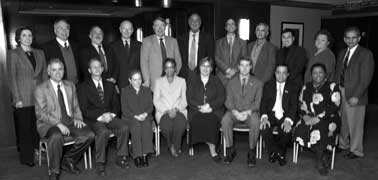
(standing left to right) Ann L. Coleman, Jack McLaughlin, Charles A. Garcia,
Robert E. Kalina, George E. Foster, David L. Epstein, Charles E. Basch, David Baldridge,
Andrew G. Lee, Norma K. Bowyer, Jose S. Pulido. (seated) Michael R. Duenas,
R. Tracy Williams, Gwen Sterns, Eve Higginbotham (chairperson),
Rosemary Janiszewski, W. Lee Ball, Satya Verma, Mildred M.G. Olivier.
Rosemary Janiszewski, M.S., CHES
National Eye Institute
Robert E. Kalina, M.D.
(term expired 11-03)
University of Washington
Seattle, WA
Andrew G. Lee, M.D.
University of Iowa Hospital
and Clinics
Jack McLaughlin, Ph.D.
National Eye Institute
Mildred M.G. Olivier, M.D.
Midwest Glaucoma Center, P.C.
Hoffman Estates, IL
Jose S. Pulido, M.D., M.S.
University of Illinois at Chicago
Paul A. Sieving, M.D., Ph.D.
National Eye Institute
Gwen Sterns, M.D.
Rochester General Hospital
Rochester, NY
Satya Verma, O.D.
Pennsylvania College of Optometry
R. Tracy Williams, O.D.
Deicke Center for Visual Rehabilitation
Wheaton, IL
David Baldridge
National Indian Project Center
Albuquerque, NM
W. Lee Ball, O.D.
Beth Israel Deaconess
Medical Center
Boston, MA
Charles E. Basch, Ph.D.
Columbia University
New York, NY
Norma K. Bowyer, O.D., M.P.H.
(term expired 11-03)
Morgantown, WV
Anne L. Coleman, M.D., Ph.D.
Jules Stein Eye Institute, UCLA
Michael R. Duenas, O.D.
Chattahoochee, FL
David L. Epstein, M.D.
Duke University Medical Center
Durham, NC
George E. Foster, O.D.
Northeastern State University
Charles A. Garcia, M.D.
Hermann Eye Center
University of Texas Medical School-Houston
Eve Higginbotham, M.D.
(chairperson)
University of Maryland
Medical Center
Baltimore, MD
43 Organizations Receive Healthy Vision Awards
The National Eye Institute (NEI) has announced the 43 recipients of the second round of Healthy Vision Community Awards. These awards will provide nearly $450,000 in funding for community-based eye health education and promotion programs targeting diabetes and glaucoma patients, people with low vision, older adults, and multicultural populations.
The NEI has significantly increased the level of funding, thus increasing the number of programs from its first round of awards. In 2003, 34 organizations were funded.
Raising Awareness
The awards will provide funds to community-based organizations to support local efforts in raising awareness about diabetic eye disease, glaucoma, and vision rehabilitation, representing three of the 10 Healthy Vision 2010 objectives. Applications numbered more than 150 for 2004.
NEI Director Paul A. Sieving, M.D., Ph.D., said, "The Institute is pleased to support the efforts of community-based organizations to improve eye health and quality of life for the people they serve. Especially important with many of the 2004 projects is the opportunity to continue to translate research results into clinical care for people with diabetic retinopathy and glaucoma. The Institute's research demonstrates that early detection and treatment can reduce vision loss." Dr. Sieving also stressed the importance of the 12 projects covering vision rehabilitation. "By increasing the use of rehabilitation services and devices, we can greatly improve the quality of life for people with low vision and help them maintain their independence," he said.
Tribal Organizations Selected
Three tribal organizations have been selected: Comanche Nation, Oklahoma; Mississippi Band of Choctaw Indians; and Sisseton Wahpeton Oyate Health Education Program, South Dakota. Four Area Agencies on Aging will receive awards: Baltimore County (Maryland) Department of Aging, Idaho Commission on Aging, and Gateway Lions and Partners with St. Louis (Missouri) Area Agency on Aging.
Two organizations have been named to receive funding for both renewal and new projects. The New England Eye Institute will continue its outreach and patient education in inner-city Boston neighborhoods and launch a project targeting older adults with low vision. The Ohio Optometric Association plans to expand its diabetic retinopathy education and initiate a pilot study for revising a national vision program.
Continuation in Funding
Seven projects have been chosen for continuation funding in 2004: Inter American University of Puerto Rico; Knox County (Illinois) Health Department; KU Health Partners, Kansas; Louisiana Eye Health Educational Institute; New England Eye Institute, Massachusetts; Ohio Optometric Association; and St. Vincent de Paul Village, California. (see "Healthy Vision Community Projects See Results" for a report on the 2003 projects.)
The announcement inviting applications for the 2005 round of funding is expected to be available in early July 2004.
Names and profiles of this year's Healthy Vision Community Award recipients are posted at www.healthyvision2010.org.
Healthy Vision Community Award Recipients
*New England Eye Institute,
Boston, MA
Northeast Valley Health Corporation,
San Fernando, CA
Oasis Institute,
St. Louis, MO
*Ohio Optometric Association,
Columbus, OH
Ohio Optometric Association-VISION USA,
Worthington, OH
Optometric Institute and Clinic of Detroit,
Detroit, MI
Prevent Blindness Nebraska,
Omaha, NE
Prevent Blindness North Carolina,
Raleigh, NC
Programa CIELO of Catholic Health Partners,
Chicago, IL
Puerto Rico Eye Care Society, Inc.,
San Juan, Puerto Rico
*St. Vincent de Paul Village, Inc.,
San Diego, CA
Senior Citizens of Patagonia, Inc.,
Patagonia, AR
Sisseton Wahpeton Oyate Health Education Program,
Agency Village, SD
Third Avenue Charitable Organization/UCSD Student-Run Free Clinic Project,
San Diego, CA
Unity Medical Center,
Grafton, ND
UP Diabetes Outreach Network,
Marquette, MI
Vista Community Clinic,
Vista, CA
Wald Community Nursing Center,
Baltimore, MD
West Virginia Health Right, Inc.,
Charleston, WV
ABVI-Goodwill Industries,
Rochester, NY
Baltimore County Department of Aging,
Baltimore, MD
Camden Eye Center,
Camden, NJ
Carroll Center for the Blind,
Newton, MA
Charles B. Wang Community Health Center,
New York, NY
Cherry Street Health Services,
Grand Rapids, MI
CITE, Lighthouse for the Visually Impaired,
Orlando, FL
Comanche Nation,
Lawton, OK
Duke Eye Center,
Durham, NC
Family Health Centers, Inc.,
Orangeburg, SC
Focus: HOPE,
Detroit, MI
Gateway Lions and Partners With St. Louis Area Agency on Aging,
O'Fallon, IL
Greater Boston Aid to the Blind,
Boston, MA
Health S.E.T.,
Denver, CO
Idaho Commission on Aging,
Boise, ID
*Inter American University of Puerto Rico School of Optometry,
San Juan, Puerto Rico
*Knox County Health Department,
Galesburg, IL
*KU HealthPartners, Inc.,
Kansas City, KS
Louisiana Department of Health and Hospitals,
Baton Rouge, LA
*Louisiana Eye Health Educational Institute,
Port Allen, LA
Matthew Walker Comprehensive Health Center,
Nashville, TN
Mississippi Band of Choctaw Indians/Choctaw Health Center,
Choctaw, MS
New England Eye Institute,
Boston, MA
* Selected for continuation award from 2003 Round.
Help Teach Children the Importance of Taking Care of Their Eyes
Order Your Activity Books TODAY!
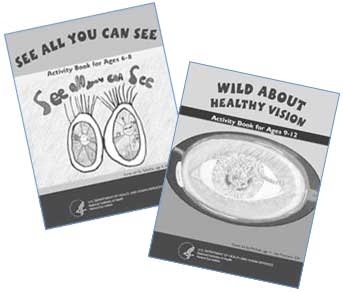
The National Eye Institute has developed activity books that will bring eye health to school-aged children. The books are designed to be interactive and full of games and activities that will make learning about the eye fun and exciting. The age-appropriate books target two age groups, 6- to 8-year-olds and 9- to 12-year-olds.
To order, call: 1-800-869-2020 or visit www.nei.nih.gov.
Lions Foundation Promotes Eye Health
The Lions Clubs International Foundation (LCIF) has launched the newly revised Lions Eye Health Program (LEHP). This community-based public awareness program allows Lions clubs, other organizations, and individuals to promote eye health in the United States. LEHP empowers communities to save sight through the early detection and timely treatment of diabetic eye disease and glaucoma and to promote low vision rehabilitation.
The foundation launched the new program on World Sight Day, October 9, 2003.
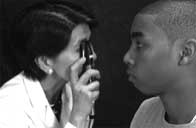
LEHP promotes early detection of
diabetic eye disease and glaucoma.
The Lions Clubs International sponsors World Sight Day to draw attention to the problem of preventable vision loss worldwide. The new LEHP is a cornerstone of that effort in the United States.
LEHP focuses on specific strategies for raising awareness of eye health. Its new CD-ROM provides in-depth instructions for setting up eye health education seminars, programming community eye screenings, and raising awareness of eye health.
LEHP has been revised and renewed in response to the emerging epidemic of diabetes and the aging of the population. Vision loss and other effects of diabetes will continue into the future. Older adults are at increased risk for vision loss from diabetes and glaucoma. The number of Americans with vision loss is expected to double over the next 20 years.
The LEHP component on low vision is new. Because many people, even many health care professionals, are unaware of the options available to those with vision loss, LEHP includes information about low vision and links to low vision resources. The emphasis is on two points:
- Vision loss is not a normal part of aging.
- Vision loss need not be the end of an independent and fulfilling life.
The revised LEHP CD-ROM includes videos on glaucoma and diabetic eye disease, public service announcements, PowerPoint presentations, and media tips to help people spread the word about eye health.
Modeled after the National Eye Health Education Program, the LEHP is made possible, in part, through educational grants from Allergan and Eli Lilly and Company.
For more LEHP information, contact Stephen Yearson at 630-571-5466 or visit the Website at www.LCIF.org.

Support Groups Help "Hard of Seeing"
For nearly 50 years, the National Association for the Visually Handicapped (NAVH) has served the needs of the "hard of seeing" exclusively. The association has developed a special understanding of the physiological and psychological effects of impaired vision and vision loss and offers support groups for those who need to know they are not alone. NAVH works hard to educate and counsel people on what they can do to make the most of their remaining vision.
Recent research findings confirm the negative impact of social isolation on both general health and psychological well-being. Since the early 1960s, NAVH has been a pioneer in the development of emotional and peer support groups.

CEO and Founder Lorraine Marchi
is working with a participant in
NAVH's support group.
In NAVH offices in New York City and San Francisco, ongoing support groups offer camaraderie, information, and a comfortable place to share the very real difficulties of managing daily life. Group discussions can range from helpful ideas for managing independent living at home to the latest research findings on low vision issues and adaptive aids. Participants are free to raise questions and concerns, knowing that they will not be embarrassed or ridiculed. Periodically, special guest speakers cover such topics as living with macular degeneration, cataracts, nutrition, and the importance of a proper lighting assessment in the home. Information on exact times and locations is available at 1-888-205-5952.
When NAVH members were asked to describe the most valuable aspects of their participation, they said the bimonthly support groups "make them feel better" and they "learn more from one another than they do from the professionals." During the support groups, the real world of visually impaired people is shared. Wonderful discoveries are made about new ways to cope with vision loss.
Partial sight leaves too many people feeling helpless and uneasy. Among visually impaired people, a loss of motivation can be even more debilitating than the loss of vision. The support groups at NAVH are designed to restore personal motivation; provide emotional support, life-enhancing ideas, and socialization; and help participants learn about how the "hard of seeing" are finding their way. More information is available by calling 1-800-677-9965.
Open Your Eyes to the Facts!
Lighthouse International is proud to offer FREE materials to the public about vision loss and how it does not relate to aging.

To order a sample packet or a free supply of materials (in English and Spanish), call 1-800-829-0500 or send an e-mail to info@lighthouse.org.
New From NEI
Essential Reading for Patients With Eye Disease
 |
 |
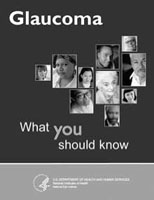 |
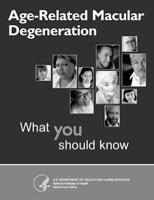 |
The four-booklet series provides information concerning what you should know about: Diabetic Retinopathy, Cataract, Glaucoma, and Age-Related Macular Degeneration.
Each booklet is in large-print format, contains descriptive illustrations, and includes:
- Latest information about detection and treatment of the eye disease
- Section on how to talk to your eye care professional
To order, call: 1-800-869-2020 or visit www.nei.nih.gov.



